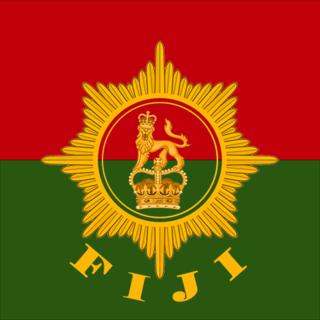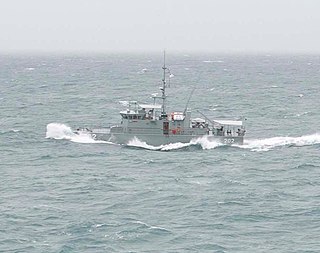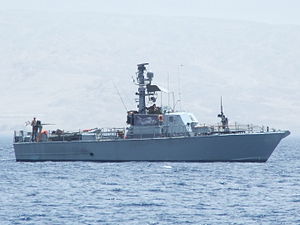
The Republic of Fiji Military Forces is the military force of the Pacific island nation of Fiji. With a total manpower of about 4,000 active soldiers and approximately 6,000 reservists, it is one of the smallest militaries in the world. The Ground Force is organised into six infantry and one engineer battalions.

A patrol boat is a relatively small naval vessel generally designed for coastal defence, border security, or law enforcement. There are many designs for patrol boats, and they generally range in size. They may be operated by a nation's navy, coast guard, police, or customs, and may be intended for marine, estuarine, or river environments.

Israel Aerospace Industries or IAI (תע"א) is Israel's major aerospace and aviation manufacturer, producing aerial and astronautic systems for both military and civilian usage. It has 15,000 employees as of 2018. IAI is completely state-owned by the government of Israel.

HMNZS Leander was a light cruiser which served with the Royal New Zealand Navy during World War II. She was the lead ship of a class of light ships, the Leander-class light cruiser and was initially named HMS Leander.

Sa'ar 5 is a class of Israeli Navy corvettes. They were Israeli designed using lessons learned from the Sa'ar 4.5-class missile boats. Three Sa'ar 5 ships were built by Huntington Ingalls Industries for the Israeli Navy, based on Israeli designs.
Dory Chamoun is a Lebanese politician who led the National Liberal Party (NLP) from 25 May 1991 till 10 April 2021 when he was succeeded by his son Camille Dory Chamoun who became a MP in the 2022 Lebanese general election. He is also a prominent member of the Qornet Shehwan Gathering, a coalition of politicians, academics, and businessmen who oppose the pro-Syrian March 8 Alliance and Syrian influence in Lebanon. He is the eldest son of late Lebanese president Camille Chamoun and brother of Dany Chamoun.

The Iraqi Naval Forces, or the Iraqi Navy, is the naval warfare service branch of the Armed forces of Iraq. Formed in 1937, initially as the Iraqi Coastal Defense Force, its primary responsibilities was the protection of Iraq's coastline and offshore assets, the official name was changed on 12 January 2005 to Iraqi Naval Forces
Operation Bayonet was a covert operation directed by Mossad to assassinate individuals they accused of being involved in the 1972 Munich massacre. The targets were members of the Palestinian armed militant group Black September and operatives of the Palestine Liberation Organization (PLO). Authorized by Israeli Prime Minister Golda Meir in the autumn of 1972, the operation is believed to have continued for over twenty years. While Mossad killed several prominent Palestinians during the operation, they never managed to kill the mastermind behind Munich, namely Abu Daoud.

The Egyptian Navy, also known as the Egyptian Naval Force, is the maritime branch of the Egyptian Armed Forces. It is the largest navy in the Middle East as well as Africa, and is the twelfth largest navy in the world. The navy protects more than 2,000 kilometers of coastline of the Mediterranean Sea and the Red Sea, defense of approaches to the Suez Canal, and it also supports for army operations. The majority of the modern Egyptian Navy was created with the help of the Soviet Union in the 1960s. The navy received ships in the 1980s from China and Western sources. In 1989, the Egyptian Navy had 18,000 personnel as well as 2,000 personnel in the Coast Guard. The navy received ships from the US in 1990. US shipbuilder Swiftships has built around 30 boats for the Egyptian Navy including mine hunters, survey vessels, and both steel and aluminium patrol boats.

The Slovenian Navy, officially the 430th Naval Division is not a separate service, but an integral part of the Slovenian Armed Forces.

The Dvora-class fast patrol boat is a fast class of patrol boats built by Israel Aerospace Industries for the Israeli Sea Corps based on the Israeli Dabur class.

The Super Dvora Mark III-class patrol boat is the latest generation of the Dvora family of fast patrol boats or fast attack craft (FPB/FAC). Manufactured by IAI Ramta in 2004 these vessels are capable of travelling up to 50 knots in littoral waters thanks to its state of the art thrust vectoring control Articulated Surface Drives (ASD) while holding various armaments, from automatic grenade launchers, AGM-114 Hellfire missiles, SPIKE NLOS missiles, and 30 mm cannons in its armory.

The Kataeb Regulatory Forces – KRF (Arabic: قوى الكتائب النظامية, romanized: Quwwāt al-Katāʾib an-Niẓāmiyyah) or Forces Regulatoires des Kataeb (FRK) in French, were the military wing of the right-wing Lebanese Christian Kataeb Party, otherwise known as the 'Phalange', from 1961 to 1977. The Kataeb militia, which fought in the early years of the Lebanese Civil War, was the predecessor of the Lebanese Forces.

The Lebanese Forces was one of the main Christian factions of the Lebanese Civil War. Originally an umbrella organization for different Christian parties, the Lebanese Forces later became a separate organization. It was mainly staffed by Maronite Christians.

RFNS Kiro (203) was one of three Pacific Forum patrol boats operated by Fiji. She was the last of the three to be launched, in May 1995, and the first to be retired, when she ran aground and was deemed unsalvable, in 2016.

RFNS Kikau (202) is a Pacific-class patrol boat operated by Fiji. She was designed and built by Australia. Australia agreed to provide twenty-two patrol boats to twelve of its neighbours and fellow members of the Pacific Forum, after the recently concluded United Nations Convention on the Law of the Sea extended maritime nations' exclusive economic zone to 200 kilometres (110 nmi). Australia provided two other patrol vessels to Fiji, Kula and Kiro. Australia also provided training and infrastructure.

HMPNGS Rabaul (01) was the first Pacific Forum patrol vessel to be commissioned, in May 1987. She is not the first vessel of the class to go out of service, because her sister ship from Fiji RFNS Kiro was wrecked in 2016. She arrived in Port Moresby, for disposal, on October 24, 2018. The vessel was named HMPNGS Tarangau.

RFNS Savenaca (401) is a Guardian-class patrol boat, being built in Australia for Fiji's Navy. She will replace RFNS Kula, a Pacific Forum patrol vessel provided by Australia in 1994. She will be the seventh vessel of the class to be completed, and the second of two to be delivered to Fiji. She will be commissioned in March or April of 2020.

The Fijian Navy was created when Fiji ratified the recently created United Nations Convention on Laws of the Sea. The Convention established that maritime nation had an Exclusive Economic Zone of 200 kilometres, which extended Fiji's waters twentyfold, from 50,000 square miles (130,000 km2) to over 1,000,000 square miles (2,600,000 km2).















